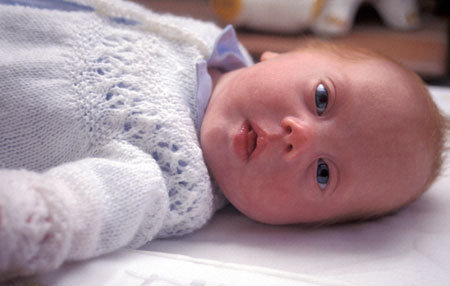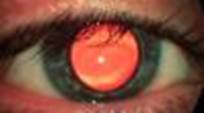Head
Molding of the head by pressure of the maternal pelvis is common after vaginal delivery. Caput succedaneum, a round boggy swelling of the soft tissues of the scalp from accumulation of fluid within the area of pressure from the pelvis during delivery is common. This should be distinguished from a cephalohematoma, which is a sub-periosteal hemorrhage. The former will cross suture lines; the latter does not.
The anterior and posterior fontanelle should be soft to palpation. The anterior fontanelle should be between 1 and 3 cm in size and the posterior fontanelle should admit a fingertip. Following a vaginal delivery, over-riding of the skull bones may temporarily reduce the size of the anterior fontanelle.
The head circumference should be between 33 and 35cm for a full-term infant.
The slant and size of the eyes should be examined. Eyes that slant upward might be a sign of Down Syndrome.
|
Down Syndrome Photo Credit: by AHMA4T Angela Hampton Picture Library / Alamy Stock Photo
|
|
Large eyes suggest congenital glaucoma, a condition that requires early treatment to preserve vision. Eyes that are too close together are suggestive of fetal alcohol syndrome.
Hemorrhage in the subconjunctival and retinal area is common with vertex delivery and has no significance. The pupillary light reflex and a red reflex of light from the retina should be checked with a flashlight or ophthalmoscope. Pupillary opacity indicates congenital cataracts and a white reflex suggests retinoblastoma
|
|
Red Reflex |
|
The pinna of the ear usually joins the head above a horizontal line from the external canthus of the eye. A low-set ear suggests chromosomal anomaly and malformed ears are associated with renal abnormalities. Babies with Down Syndrome also may have small ears that fold over on top. However, a pre-auricular skin tag is usually of no significance.
The nose should be checked for patency by auscultation with a stethoscope. Babies are obligate nose breathers for the first few months of life and blockage of the nasal canal, or choanal atresia, can be life-threatening. The nose in Down Syndrome may be small, with a flattened nasal bridge.
A neonatal tooth is occasionally observed and usually requires extraction. The palate should be examined for the presence of a cleft. The neck should be checked for webbing, mass, or goiter. |





